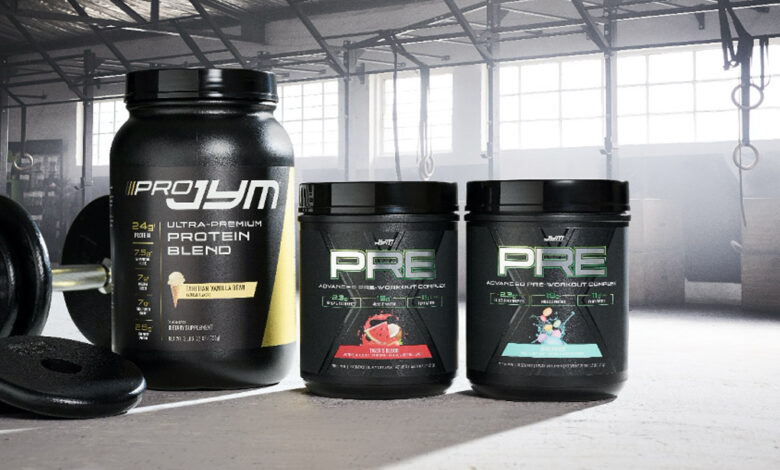4 Ways to Take Your Fat Loss to the Next Level

This is sponsored content. M&F is not endorsing the websites or products listed in this article.
Are you struggling to get shredded, stuck on a dreaded fat loss plateau where no workout or diet you try gives you the results you want? There could be any number of reasons you’re failing to thrive in getting lean. But if I had to guess, I’d say that at least one of the below four reasons is likely a culprit in your stalled fat loss progress.
These tips span from nutrition to training to supplements. Get on board with them, and your physique will be on the fast track to shredded.
1) Bump Up Your Protein Intake
You may be wondering what increasing your protein intake has to do with losing body fat. Eating a high protein diet only affects muscle building and strength levels, right? Wrong. Consuming more protein could also help you get leaner.
Here’s some compelling evidence. One study by researcher Jose Antonio and published in a 2016 issue of the Journal of the International Society of Sports Nutrition put trained subjects on one of two diets: one diet providing 1 gram of protein per pound of bodyweight per day (ie, 200 grams of protein for a 200-pound person), and the other 1.5 grams per pound per day (300 grams of protein for a 200-pounder).
The results of the study found that those consuming 1.5 grams per pound daily lost an average of 5 pounds more body fat over an 8-week period than those consuming 1 gram per pound – this despite consuming 500 more calories per day. That’s not a typo. The group consuming 500 more calories daily shed more fat. Safe to say this happened because those additional calories came from protein, as higher protein intake increases metabolic rate and energy expenditure.
The take-home here is clear: To maximize fat loss, aim to consume 1.5 grams of protein per pound of bodyweight every day. Getting all that from food would be great, but it’s not practical for most people. This is where protein powders come in; they’re not only convenient, but they make it very easy to fit into any macronutrient-driven diet, as most powders are predominantly protein with very little carbs or fat.
If you’re looking for a high-quality protein powder, I have three great products to choose from, all available at Vitamin Shoppe: Pro JYM, which is a blend of whey, casein, and egg protein; Iso JYM, which is pure whey protein isolate (WPI); and Plant JYM, which is purely plant-based, consisting of pea and rice protein isolates.
2) Eat the Right Carbs at the Right Times
Of the three macronutrients, carbohydrates are by far the most confusing for people. Carbs also tend to be one of the main reasons people hit fat loss plateaus and become frustrated with their results. Because I don’t want to further confuse anyone, I’ll try and keep my carb advice very simple.
First of all, completely eliminating carbs altogether in one fell swoop (via a super low-carb or no-carb diet like keto) is one of the worst things you can do. Sure, you might have some good short-term results where you lose a ton of weight in a matter of weeks. Besides the fact that this short-term weight loss is mostly water, not fat,the main problem with drastically dropping carb intake is that once your fat loss stalls, where do you go from there? If you’ve already eliminated all carbs, you can’t drop them anymore! This makes people frustrated and discouraged, which usually leads to quitting the diet altogether and gaining all the weight back.
Here’s a better solution: Start out your diet by consuming somewhere around 2 grams of carbs per pound of bodyweight (which will allow you to enjoy a good number of the carb foods you enjoy), and stick with that as long as you’re still seeing results in fat loss. Once you hit a plateau and aren’t losing fat anymore, drop your carb intake by a mere 0.25 gram per day (down to 1.75 grams per day), sticking with that as long as you’re seeing good results. From there, repeat the process: drop your carb intake by 0.25 gram per day when fat loss stalls. This is a much more sustainable, and enjoyable, approach.
So, what types of carbs to eat? Again, I’ll keep this simple. Choose low-glycemic carb sources like oats, potatoes, vegetables, and fruit at all times of the day except immediately after workouts. Post-workout, go with fast-digesting carbs (aka, sugars) from sources like white bread or any high-dextrose (glucose) source. Pixy Stix and Haribo Gummy Bears are my two favorite dextrose-rich post-workout carb sources, and I also have a post-workout carbohydrate product – Post JYM Fast-Digesting Carb. After workouts, fruit is actually not an ideal carb source; fruit is high in fructose, which isn’t as easily processed by the body as dextrose or glucose.
So that’s carbs in a nutshell: Don’t drop them too much too soon, go with fast carbs after workouts, and go with slow carbs at all other times.
3) Take a Fat-Burner That Actually Works
Make no mistake, maximizing fat loss primarily comes down to proper nutrition and a consistent training program that boosts metabolic rate and burns calories through adequate volume and high intensity (among other variables). But to get that little bit of extra help in leaning out, a fat-burning supplement can certainly help.
Problem is, most fat burners on the market are made up of stimulants and very few (if any) ingredients actually shown through scientific research to help the body safely and effectively burn fat.
When I started JYM Supplement Science back in 2013, I was determined to formulate a fat burner that actually worked – but without the marketing hype promising some sort of “magic pill.” My first fat burner was Shred JYM, and it proved to be a very effective product that I took myself (along with many thousands of others) for years. More recently, I’ve come up with an even better fat loss product, based on newer research. That product is my SS8 Advanced Fat Burner, also available at Vitamin Shoppe.
SS8 contains 10 research-backed ingredients, some of which are also contained in my original Shred JYM formula. (I’ve listed all 10, including doses, below.) Collectively, these ingredients assist in fat loss via three mechanisms: (1) helping to prevent the storage of body fat; (2) promoting the conversion of fat into “active” tissue; and (3) helping the body burn more calories.
One nice thing about SS8 is that you only have to take it once a day (via a four-capsule dose), with or without food. Of course, the really nice thing about SS8 is that it actually works at giving you that little extra fat-burning boost!
SS8 Advanced Fat Burner Ingredients
- 400 mcg Chromium Picolinate Chromax®
- 5 g Acetyl-L-Carnitine
- 555 mg Green Tea Extract
- 100 mg Caffeine Anhydrous
- 200 mg ZumXr® Time-Released Caffeine
- 5mg Yohimbe
- 500mcg Rauwolscine
- 40 mg CaloriBurn® (Grains of Paradise)
- 500 mg L-Tyrosine
- 50 mg Capsimax® Cayenne Pepper Extract
4) Optimize Your Training Intensity
Your training should always match your goals, especially when it comes to maximizing fat loss. The main training variables that directly impact fat loss are training frequency, training volume, exercise selection, and training intensity.
When it comes to training frequency, I mean the number of times per week you train each major muscle group. For fat loss, your best bet is to train each muscle group at least twice a week, if not three or more times. A “bro split,” where you’re training only one or two muscle groups a day, and only hitting each once a week, is not your best bet for losing fat. Rather, you should either be doing a full-body split where each muscle group is trained 3-5 days a week; a 3-day split repeated twice for six weekly workouts (each muscle group trained twice a week); or a 2-day split (ie, an upper-lower split) repeated three times a week so that each muscle group is trained three times a week.
When it comes to training volume, if your frequency is in accordance with what I just explained in the previous paragraph, your volume should be sufficient. Simply put, a relatively high training volume is ideal for losing body fat because it will have you hitting more muscle fibers and thus burning more calories.
Keep in mind, the volume or amount of work you do lifting weights also greatly influences how your body uses and stores carbohydrates. In essence, carbohydrates are needed to fuel high-intensity weight training sessions and are also preferably stored in muscle post-exercise as glycogen. The net effect can be less energy from carbs being available to be stored as fat, which over time makes a dramatic difference in your body fat ratio.
This is why I recommend at least 20 sets per workout across whatever muscle groups you’re training that day.
As for exercise selection, you want to do as many compound (multijoint) exercises as possible – as opposed to building your routine around isolation (single-joint) moves. Compound exercises like squats, lunges, presses, and rows are going to stimulate the greatest number of muscle fibers, which will burn more calories both during workouts and after, and overall maximize your resting metabolic rate.
Finally, training intensity. The key here isn’t so much about going light versus training heavy, because the truth is, both high reps and light weights and low reps and heavy weights can be highly effective for burning fat. The important thing is training to failure, whether you’re going light or heavy. You don’t need to take all of your sets to failure, but if you want to maximize fat loss, you should be taking at least most of your sets to the point of full muscle fatigue.
One other variable that directly affects intensity is rest periods; generally speaking, the shorter the rest periods between sets, the higher the intensity. This is not to say you can’t get lean resting 2-3 minutes between sets, because you can certainly can if your nutrition is on point. But for best results, try and limit rest periods to 60 seconds or less when your primary goal is fat loss.
One last thing: cardio. The research is very clear that high-intensity interval training (HIIT) is far superior for fat loss than steady-state low-intensity cardio. You’re better off sticking to short, intense cardio sessions (like Tabatas and work-to-rest ratios in the 1:1 or 2:1 range) rather than wasting your time with 30-60-minute sessions on a piece of cardio equipment. Steady-state cardio has its place, but it’s not very efficient for fat loss.
When it comes to training to maximize fat-burning, keep it frequent, keep it intense, and always focus on “big” compound exercises.
References:
Antonio, J., et al. The effects of a high protein diet on indices of health and body composition – a crossover trial in resistance-trained men. Int Soc Sports Nutr 13:3, 2016.
Romijn J, Coyle E, Sidossis L, Gastaldelli A, Horowitz J, Endert E, et al. Regulation of endogenous fat and carbohydrate metabolism in relation to exercise intensity and duration. Am J Physiol Endocrinol Metab. 1993;265(3):E380–91.
van Loon LJ, Greenhaff PL, Constantin-Teodosiu D, Saris WH, Wagenmakers AJ. The effects of increasing exercise intensity on muscle fuel utilisation in humans. J Physiol.
This content provided by our partners at PRO JYM.




